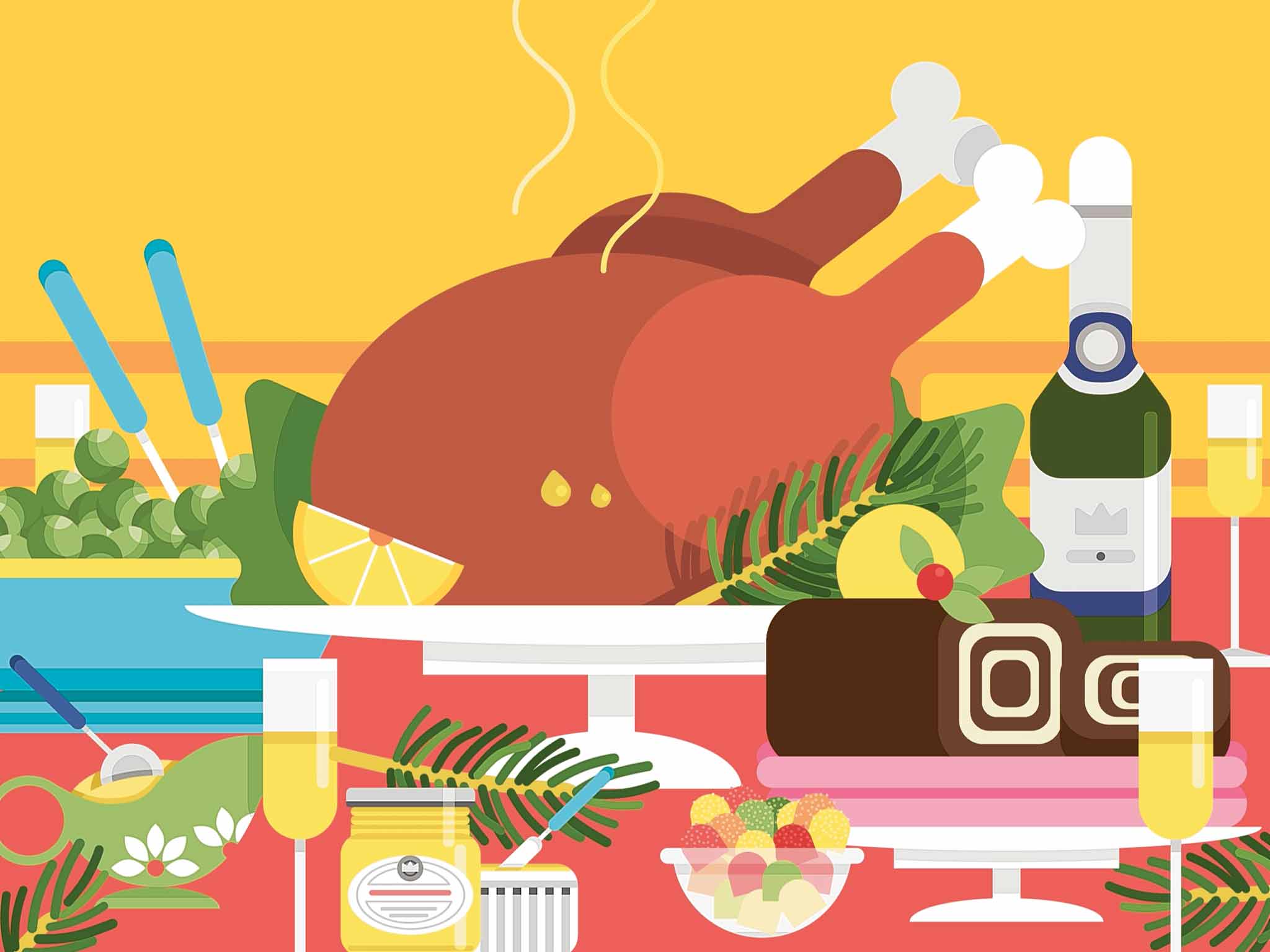Christmas food A-Z: From Asti Spumante and Brussels sprouts to yule logs and zzzzz
Food that comes into its own at Christmas is a wonder in itself

Your support helps us to tell the story
From reproductive rights to climate change to Big Tech, The Independent is on the ground when the story is developing. Whether it's investigating the financials of Elon Musk's pro-Trump PAC or producing our latest documentary, 'The A Word', which shines a light on the American women fighting for reproductive rights, we know how important it is to parse out the facts from the messaging.
At such a critical moment in US history, we need reporters on the ground. Your donation allows us to keep sending journalists to speak to both sides of the story.
The Independent is trusted by Americans across the entire political spectrum. And unlike many other quality news outlets, we choose not to lock Americans out of our reporting and analysis with paywalls. We believe quality journalism should be available to everyone, paid for by those who can afford it.
Your support makes all the difference.A is for Asti Spumante
The words alone fizz with decadence. Smell the cool breeze that rolls in off the Ligurian sea… Then you taste it and, oh my! Both sickly sweet and low in alcohol content, where will the night end? Who knows, but given that it's Christmas, passed out in front of the telly is a safe bet. A downmarket air may cling to the brand but while some may mock it as poor man's Champagne, we say more fool them. Serve with Ferrero Rocher for the ultimate in retro decadence.
B is for Brussels sprouts
Despite the Belgian capital putting in an appearance in the name, it is we Brits who eat the most Brussels sprouts in Europe: Morrisons alone sells 650 tonnes of these “Christmas cabbages” each week in December. Though a festive staple, sprouts remain an opinion-divider flavour-wise due to their high sulphur levels. In nature, this helps ward off herbivorous nibblers. But add a bit of heat and a greedy human and they stand no chance. The association with Christmas is down to the fact that sprouts grow in cold conditions.
C is for cheese
It was a mint that did for Mr Creosote. Presented with one along with the assurance it was only “wafer-thin” in Monty Python's The Meaning of Life, he eats it and promptly explodes. In reality, it would more likely be the cheese course that led to such an eruption – a sliver of Comte, perhaps. Typically served with crackers, chutney and grapes, your basic board should include a hard cheese (Cheshire, Lancashire), a soft cheese (camembert, brie) and a blue cheese (Stilton, Cabrales). Add to this as you wish. But hold the Babybel.
D is for dates
Inexplicably packaged with those white plastic sticks (an eating implement? Adornment? Or a joust for a post-prandial duel?) dates were, until the 1960s, rarely seen outside of the festive season. They now fall into the same category as nuts and satsumas – foodstuffs that are obligatory at this time of year, but superfluous. Not in a good superfluous way, mind, like, say, candy floss. More that they should have been consigned to the compost heap when refrigeration came along. One exception: Medjool dates, which are rather nice.

E is for eggnog
The word eggnog is a mishmash of “grog” (a slang word for rum), “noggin” (Middle English for a small measure of alcohol) and the star ingredient: egg, which is usually whipped to give a delightfuly frothy texture. Presumably the name was first uttered by someone attempting to order a “noggin of egg grog” after one too many. Apparently, like a fine wine, eggnog matures with age. Leave a bottle for a year or two and the bouquet of ovum will improve no end.
F is for fish
In as much as there is a Christmas Eve dish, it is fish. This all began with the Catholic Church's observance of 24 December as a day of abstinence – with meat to be avoided. The Feast of the Seven Fishes, originating in southern Italy, is now more commonly observed in Italian-American households. While tradition dictates the serving of, yes, seven different fish dishes, in these days of plenty, nine, 11 and 13 dishes aren't unheard of. As a guide, chef Mario Batali recommends clams with oregano, fresh anchovies, linguine with clams, spaghetti with mussels, salt cod with tomatoes andcapers, jumbo shrimp marsala “house-wife style”, and eel livernese.
G is for glühwein
If Christmas were a flavour, it would likely be glühwein. Cloves, cinnamon, nutmeg, fruit and hot booze make for a heady mix. Delicious, with a suggestion of the restorative – which is, of course, entirely unfounded. Brits call it mulled wine but, as with the best Christmas traditions, the idea originated in Germany. A gold-plated glühwein tankard belonging to Johann IV, Count of Katzenelnbogen, dates back to 1420. The glüh comes from “glow”, because of the visual effect of the hot irons that were placed into the wine to heat it.
H is for humbug
They may look like dead cockroaches, candied and ensconced in cellophane evidence bags. But the humbug is in fact the culinary anti-hero of Christmas. Yes, Ebenezer Scrooge and his catchphrase “Bah! Humbug!” had a great deal to do with this. But in its meagreness, the humbug is the antithesis of festive overindulgence.
I is for Irish Cream
While you'd be forgiven for thinking that Irish Cream was dreamt up by the Victorians, it in fact comes from another historical era in which a strong desire for gout apparently dictated the nation's tastes: the 1970s. Arriving on the scene in 1974, Baileys quickly became associated with Christmas when somebody had the realisation that it was a pretty nifty way to ingest yet more calories. Chocolate cherry and orange truffle are but two variants Baileys have trialled over the years.
J is for jellied fruits
When it comes to thoughtless gifting, Toblerone suffices for most of the year, but Christmas has its own tradition. Newberry Fruits boasts of having made the original fruit jellies, in all their squidgy, luminous glory, for more than 100 years.
K is for KFC
Only one per cent of the Japanese population is Christian and Christmas is not a national holiday in the country. Yet, back in 1974, some wily Don Draper-type, came up with the “Kurisumasu ni wa kentakkii!” campaign. Translating as “Kentucky for Christmas!” it has kept families there queuing around the block on 25 December for deep-fried chicken ever since.
Lis for lobster
Long thought of as the pinnacle of decadence – a centrepiece to sit beside your pig's-head-choking-on-a-Red-Delicious – thanks to Colin Farrell, and his film The Lobster, the terracotta crustacean became a thing in 2015 – something you may become should you fail to find a life partner (see U). And now that the real thing is only a fiver in Lidl, you can't help but think some of the je ne sais quoi has been stripped away.
M is for mince pies
Now, we know it's not terribly fashionable to side with the crusaders – but they did bring us back mince pies. In their original form, the pastry cases contained minced meat preserved with alcohol, fruit and spices. The meat, over time, was done away with. Mince pies made > a second controversial historical appearance when Oliver Cromwell banned the poor buggers due to their association with Catholicism and all things Christmas. So, both the food of the persecutors and the persecuted. Something to think about as you wolf down your sixth of the day
N is for nutroast
The festive “veggie option” is much maligned. But until the 1950s, nutroast played a far greater role on the Christmas dinner table as a cheap supplement to the turkey. Mix nuts, breadcrumbs, some veg and an egg and you're away.
O is for oysters
The oyster is to the seafood counter what Jay-Z is to popular culture. From a lowly start on the mean streets of Medieval England, were it was used to bulk up meat stews, the gnarly little crustacean has reached new heady heights. It's the kind of story you could build a pop career on and, naturally, Christmas is the oyster's time to shine. Kilos of the things – a not-too-distant cousin of the garden snail – will be shucked and sauced and wielded with aplomb by hands at cocktail parties from Glasgow to Guernsey. If you're feeling particularly extravagant, Escoffier does a fine recipe for puff pastry canapés filled with caviar, topped off with these luxurious little blighters.
P is for pigs in blankets
Even the most comprehensive food histories omit an entry for pigs in blankets. But, in our book, the first person to wrap a sausage in a rasher of bacon is a person truly deserving of sainthood.
Q is for Queen's speech
If Christmas dinner wasn't stressful enough – what with military timings, a 4.30am alarm to get the beastly fowl in the oven, and the very real likelihood that it will, despite being lovingly basted, be as dry as old biscuits – there's also always someone who wants to have the plates cleared and to be sitting in front of the TV, ready for HM at 3pm. We're tired, leave us alone.
R is for roasties
If Christmas dinner was a Palladian villa, the roast potato would serve the function of a supporting pillar. It is hard to overstate the importance of a perfectly done King Edward, all crisp exterior and fluffy innards. It provides texture! Carbohydratic support! And is a vehicle for all those other delicious flavours on the plate. Thank you Sir Walter Raleigh for delivering us this humble Spanish tuber.
S is for snowball
Eggs, sugar, brandy and lemonade, you might think, do not a drink maketh. And you'd be wrong. Because it does. All hail the Snowball. The first three ingredients come blended into Advocaat, a drink the consistency and colour of an open wound long past its best. Dollop into a glass, chuck in an equal part of lemonade, et voilà! Serve with the fascinating fact that Advocaat comes from the Dutch for lawyer.
T is for turkey
Should you have walked down what is now the A12 leading from Lowestoft to London during any of the autumn months in the early 1700s, you would have been met with quite the sight. A quarter of a million turkeys a year were marched down the road to the capital. Their feet were dipped in tar and their handlers would make frequent stops to ensure they did not lose precious weight from over-exertion. To this day, the majority of our turkeys are still reared in East Anglia. First brought to England from North America in 1526, the fowl's association with Christmas was cemented in the 20th century when Edward VII replaced the peacock with the turkey on the royal table.
U is for unwanted guest
Uncle Bob! You're still here! And you're even more unsavoury and foul-tempered than last year. Yes, we know that Auntie Caroline left you to shack up with that man from next door. And yes, she's packed the kids off to Cleethorpes. And she's taken the car. You mentioned all of this on the 19th, when you arrived – and have done every day since. By the way, did you say you had booked a return train? Because we will need the room back for New Year.
V is for vermouth
One of the bouffées délirantes that tends to sweep through British households at this time of year is the bright idea of making one's own cocktails. Because why get one kind of drunk, when you can get many different kinds? Vermouth – the backbone of the martini, the negroni, and the like – will be a casualty of this endeavour. The bottle, three-quarters full, will sit at the back of the drinks cabinet, gathering dust until next year. Along with all thos other drinks you keep in “just in case”.
W is for whisky
Do you take your whiskey with an 'e'? If so, it's of the Irish variety (whiskey). Sans and it's Scotch (whisky). If, over the festive period, you find yourself caught between uncle James and uncle Connor arguing over which side of Malin Head the dark grain spirit was first produced, you can interject with firm authority that it was most certainly to the east. A very long way to the east, in fact, because whiskey was being distilled on the Indian subcontinent as early as 500BC. The go-to “dad present” – but don't settle for a bottle of Teachers. Push the boat out with the more challenging flavours of Talisker or Glenrothes.
X is for XO Chicken
Chicken and XO sauce is a firm favourite of the Chinese takeaway. But what the blinking heck does it have to do with Christmas, we hear you ask. Well, while you may be foaming at the mouth with festive cheer like a rabid reindeer, or a child full of Fanta and Mentos, it may have escaped you that not everyone else is. If you're a member of the US Jewish community, tradition dictates that you order in from that other non-conforming population, the Chinese-Americans.

Y is for yule log
In a fantastic piece of culinary literalism, sometime in the 19th century, the French fashioned a cake to look like the log traditionally burned in the hearth at Christmas. Typically made from chocolate sponge, this is a fab way to keep the kids entertained for eight minutes or so. Encourage them to adorn said cake with nuts for rocks, icing sugar that shimmers like morning frost, and marzipan snowmen that look like marzipan snowmen. Beats that boring old log in the grate any day of the week, if you ask us.
Z is for zzzzz
So, here we are. You've consumed four million calories, had an indigestion or pulmonary embolism moment or two and given your liver a thoughtful pre-NYE heads up. You have/haven't punched anyone/made someone cry/been punched/cried (delete as appropriate). One last mouthful and then, eyes on the prize – must get to the sofa before these other gluttons. Is it me or is the heating on awfully high? Time to remove a few layers and get comfortable. Oh God, did someone mention Christmas pudding?
Join our commenting forum
Join thought-provoking conversations, follow other Independent readers and see their replies
Comments